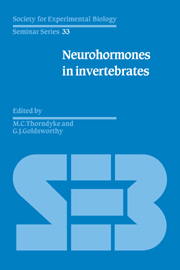Book contents
- Frontmatter
- Contents
- List of contributors
- Preface
- What is special about peptides as neuronal messengers?
- Part I Immunocytochemistry and Ultrastructure
- The new neurobiology – ultrastructural aspects of peptide release as revealed by studies of invertebrate nervous systems
- Immunocytochemistry of hormonal peptides in molluscs: optical and electron microscopy and the use of monoclonal antibodies
- Immunocytology of insect peptides and amines
- Immunocytochemistry and ultrastructure of crustacean endocrine cells
- Part II Arthropod Neurohormones
- Part III Neurohormones in Coelenterates, Annelids and Protochordates
- Part IV Neurohormones in Molluscs
- Index
Immunocytochemistry and ultrastructure of crustacean endocrine cells
Published online by Cambridge University Press: 04 August 2010
- Frontmatter
- Contents
- List of contributors
- Preface
- What is special about peptides as neuronal messengers?
- Part I Immunocytochemistry and Ultrastructure
- The new neurobiology – ultrastructural aspects of peptide release as revealed by studies of invertebrate nervous systems
- Immunocytochemistry of hormonal peptides in molluscs: optical and electron microscopy and the use of monoclonal antibodies
- Immunocytology of insect peptides and amines
- Immunocytochemistry and ultrastructure of crustacean endocrine cells
- Part II Arthropod Neurohormones
- Part III Neurohormones in Coelenterates, Annelids and Protochordates
- Part IV Neurohormones in Molluscs
- Index
Summary
The crustacean neuro-endocrine system has an extensive and diverse organisation (GABE 1966). It includes the Y-organs, mandibular organs and gonads as well as all parts of the nervous sytem (NS) (Echalier 1954; Le Roux 1968; Charniaux-Cotton 1954; Juchault 1966).
This chapter will concentrate on the peptidergic and aminergic areas of the NS, utilizing the isopod model as a framework upon which to base comparative data obtained from decapods.
The neurosecretory cells
The Isopod brain comprises 3 major areas: protocerebrum, innervating the compound eyes; deutocerebrum, innervating the antennule; and tritocerebrum, innervating the antennary.
Neurosecretory products are often revealed by standard histological techniques such as paraldehyde fuchsin (PF) and chrome hematoxylin phloxine (CHP). We have used these techniques to locate 4 types and subtypes of neurosecretory cells (NSC) in the NS (Martin 1981), and the ones described here will be restricted to those terminating in the sinus gland (SG), following the pattern established by the cobalt back-filling experiments of Chiang and Steel (1985a). NSC are classified according to the terminology introduced by Matsumoto (1959).
β-cells: These comprise a group of heterogeneous cells, located in the anterior part of the protocerebrum, on each side of the midline (Fig. 1a; 1c).
Subgroup β1 contains 6 cells, which are polygonal, 14–28 μm in diameter which stain intensely with both PF and CHP. Ultrastructure shows an ovoid nucleus, stacks of RER, Golgi-derived electron dense granules (160-180 nm) and glycogen particles associated with electron lucent vacuoles (Fig. 1d).
- Type
- Chapter
- Information
- Neurohormones in Invertebrates , pp. 79 - 96Publisher: Cambridge University PressPrint publication year: 1988
- 6
- Cited by



